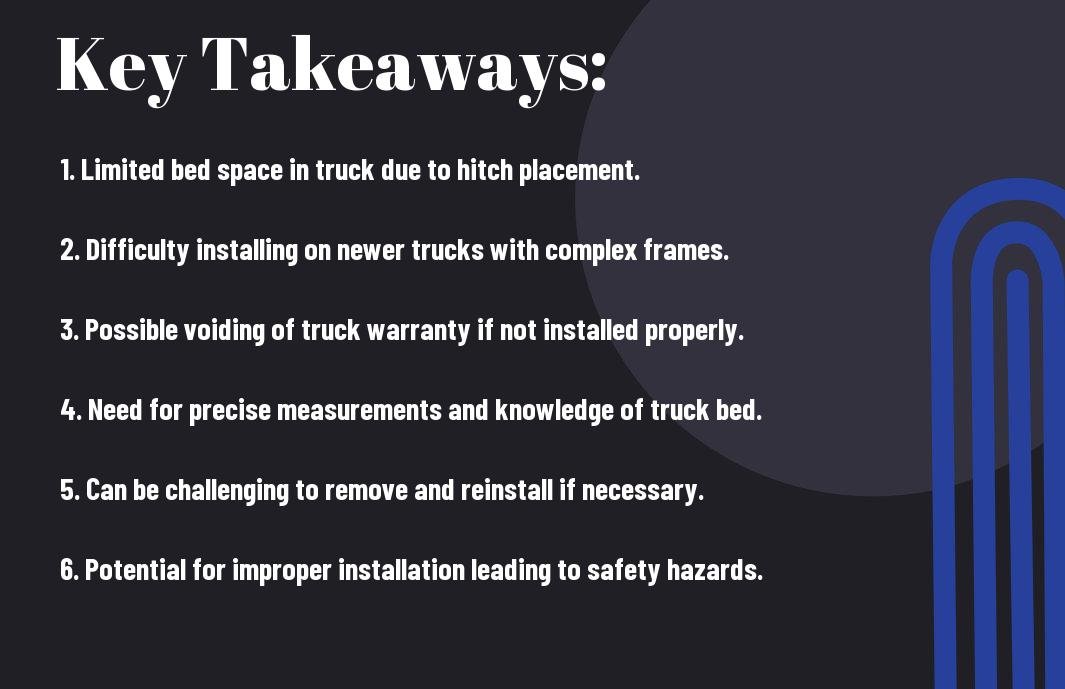Are you considering installing a fifth wheel hitch on your vehicle? While the fifth wheel hitch is a popular choice for towing heavy loads, it does come with its disadvantages. One of the key drawbacks of the fifth wheel hitch is its complexity and difficulty of installation. Unlike other types of hitches, the fifth wheel hitch typically requires professional installation due to its complicated mounting system and the need for precise measurements. However, if you have the necessary skills and tools, you can install your own fifth wheel hitch. It’s crucial to carefully follow the manufacturer’s instructions and ensure that the hitch is properly secured to your vehicle to avoid any safety hazards while towing.
Key Takeaways:
- One disadvantage: The fifth wheel hitch can limit the bed space of your truck, making it less versatile for hauling other cargo.
- Installation: Yes, it is possible to install your own fifth wheel hitch, but it requires a certain level of mechanical skill and understanding of your specific truck’s towing capacity.
- Tools: You will need specific tools and equipment to properly install a fifth wheel hitch, including a drill, wrenches, and possibly a torque wrench.
- Weight capacity: It’s important to ensure that the fifth wheel hitch you install can safely handle the weight of the trailer you plan to tow.
- Warranty: If you install the fifth wheel hitch yourself, it may void any warranty on the hitch or your truck, so consider this carefully before proceeding.
- Leveling: It can be challenging to properly level and adjust the fifth wheel hitch for optimal towing performance without professional assistance.
- Legal requirements: Installing a fifth wheel hitch may require adherence to certain legal guidelines and regulations, so be sure to research and follow these accordingly.

Understanding Fifth Wheel Hitches
Obviously, before delving into the potential disadvantages of the fifth wheel hitch, it’s important to understand what it is and how it differs from other types of hitches. In this section, we will take a closer look at the fifth wheel hitch, its definition, use, and how it compares to other hitch types.
Definition and Use
The fifth wheel hitch is a type of hitch used for towing heavy loads, typically in the range of 12,000 to 30,000 pounds. It is commonly used for towing large recreational vehicles (RVs), horse trailers, and other heavy-duty trailers. The hitch is mounted in the bed of a pickup truck, providing a secure connection between the truck and the trailer. Its unique design allows for greater stability and maneuverability compared to other hitch types, making it a popular choice for those hauling heavy loads.
Comparison with Other Hitch Types
When comparing fifth wheel hitches to other hitch types, such as ball hitches and gooseneck hitches, there are several key differences to consider. The fifth wheel hitch provides a smoother and more stable towing experience, particularly for heavier loads. It also allows for tighter turns and better maneuverability, making it a preferred choice for those towing large trailers. However, it does require a pickup truck with a specialized mounting system, which may limit its compatibility with other vehicles. The gooseneck hitch, on the other hand, is often easier to install and remove, making it a more versatile option for different types of towing needs. The ball hitch is commonly used for lighter loads and is easier to install, but it lacks the stability and towing capacity of a fifth wheel or gooseneck hitch. The fifth wheel hitch is also known to be more expensive and may require professional installation for optimal safety and performance.
| Hitch Type | Key Differences |
|---|---|
| Fifth Wheel Hitch | Greater stability and maneuverability, smoother towing experience |
| Gooseneck Hitch | Easier installation and removal, versatile for different towing needs |
| Ball Hitch | Used for lighter loads, easier to install, lacks stability and towing capacity |
The important feature of a fifth wheel hitch is its exceptional stability and maneuverability for towing heavy loads. The gooseneck hitch offers versatility and ease of use, while the ball hitch is better suited for lighter loads. It’s essential to consider your specific towing needs and vehicle compatibility when choosing the right hitch for your trailer. The fifth wheel hitch may offer superior performance but requires careful consideration and investment in the appropriate setup for your truck and trailer.
Disadvantage of Fifth Wheel Hitches
Not to scare you off, but there are a few disadvantages to consider before installing a fifth wheel hitch in your vehicle. While they are a popular choice for towing large trailers, they do have some drawbacks that you should be aware of.
Maneuverability Challenges
When you have a fifth wheel hitch installed in your vehicle, you may encounter some challenges when it comes to maneuvering. The hitch is located in the bed of the truck, which means you have limited space to make tight turns. This can make it difficult to navigate through tight spaces, such as parking lots or narrow streets. You will need to be extra cautious while driving, as sharp turns can be tricky to execute without hitting obstacles or damaging your trailer.
Impact on Vehicle Usage
Having a fifth wheel hitch installed can also impact your vehicle’s usability. The hitch takes up a significant amount of space in the bed of your truck, which limits the amount of cargo or gear you can carry. In addition, the weight of the hitch and the trailer can affect your vehicle’s performance, including acceleration, braking, and fuel efficiency. It’s important to consider these factors when deciding if a fifth wheel hitch is the right choice for your towing needs.
DIY Installation of Fifth Wheel Hitches
To ensure your fifth wheel hitch is properly installed, you can consider doing it yourself. However, keep in mind that the process can be complex and time-consuming. It’s crucial to have a good understanding of the process and access to the right tools and materials to complete the installation correctly.
Required Tools and Materials
Before you start the installation process, it’s important to ensure you have all the necessary tools and materials. You will need a socket set, torque wrench, drill, drill bits, screwdrivers, measuring tape, a level, and safety goggles. Additionally, you will need the fifth wheel hitch kit, which includes the hitch itself, mounting brackets, and hardware.
Step-by-Step Installation Guide
When installing a fifth wheel hitch, it’s crucial to follow a step-by-step guide to ensure proper installation. Below is a general guide for installing a fifth wheel hitch. Keep in mind that specific instructions may vary depending on the make and model of your vehicle and the hitch you are installing.
Step 1: Assemble the mounting brackets according to the manufacturer’s instructions.
Step 2: Position the hitch in the truck bed and mark the location for the mounting brackets using a measuring tape and a level.
Step 3: With safety goggles on, use a drill to create holes for the mounting brackets.
Step 4: Attach the mounting brackets to the truck bed using the provided hardware.
Step 5: Install the fifth wheel hitch onto the mounting brackets following the hitch manufacturer’s instructions.
Step 6: Use a torque wrench to tighten all the bolts to the recommended torque settings.
Step 7: Perform a thorough inspection to ensure the hitch is securely installed before towing your fifth wheel trailer.
Conclusion
Summing up, one disadvantage of the fifth wheel hitch is that it can limit the bed space of your truck, making it difficult to haul other types of cargo. Additionally, it may require professional installation to ensure proper and safe setup. However, it is possible for you to install your own fifth wheel hitch if you have the necessary tools and expertise. Just be sure to follow the manufacturer’s instructions carefully and double-check your work to ensure a secure and safe installation. Keep in mind that improper installation could lead to potentially dangerous situations on the road, so it’s crucial to take every precaution when installing a fifth wheel hitch yourself.
FAQ
Q: What is one disadvantage of the fifth wheel hitch?
A: One disadvantage of the fifth wheel hitch is its overall weight and size, which can make it more difficult to handle and maneuver compared to other types of hitches.
Q: Can I install my own fifth wheel hitch?
A: While it is possible to install your own fifth wheel hitch, it is not recommended unless you have experience with similar types of vehicle modifications and have the appropriate tools and equipment. Improper installation can result in serious safety risks and damage to your vehicle.
Q: What are some common issues with fifth wheel hitches?
A: Common issues with fifth wheel hitches include rust and corrosion, wear and tear on moving parts, and potential misalignment if not installed or maintained properly. These issues can affect the overall performance and safety of the hitch.
Q: Is a fifth wheel hitch compatible with all vehicles?
A: No, a fifth wheel hitch is not compatible with all vehicles. It is typically designed for use with pickup trucks and certain types of RVs and trailers. Proper compatibility should be verified before attempting to install a fifth wheel hitch.
Q: How do I maintain a fifth wheel hitch?
A: To maintain a fifth wheel hitch, regular inspections and lubrication of moving parts are essential. Additionally, it is important to keep the hitch clean and free of debris, and to address any signs of wear or damage promptly. Regular maintenance can help extend the lifespan and ensure the safety of the hitch.
